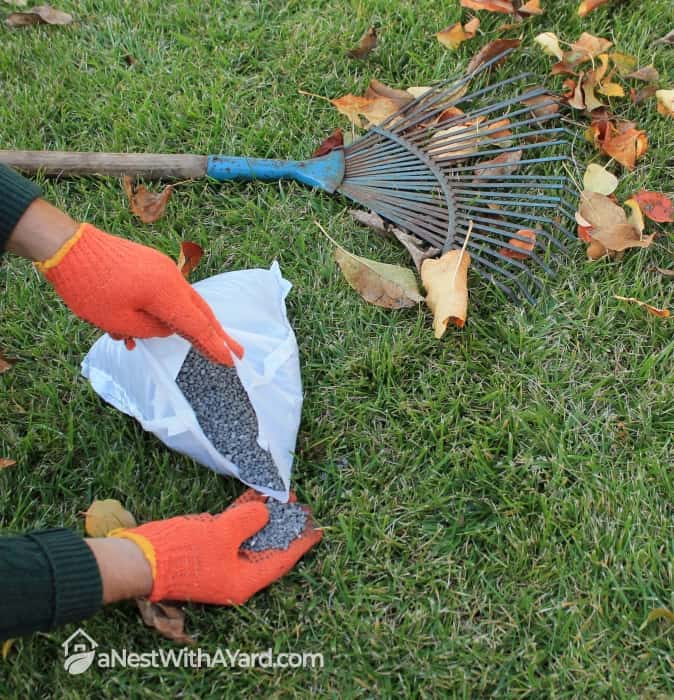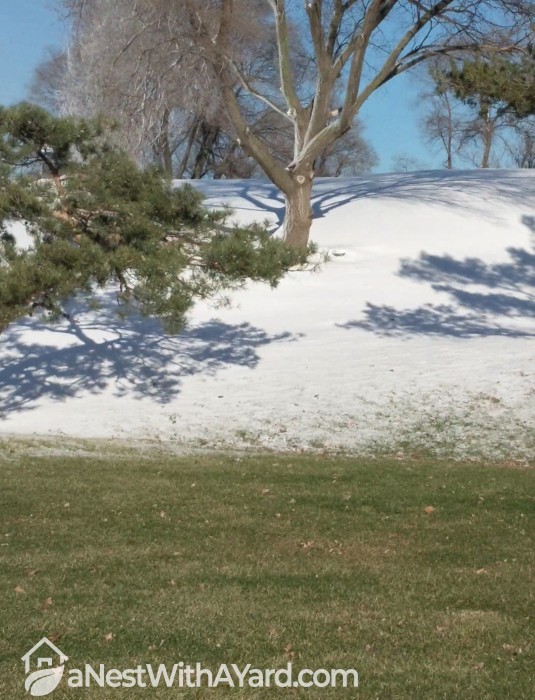The best time to apply fall lawn fertilizer to protect your lawn during winter dormancy, provide better winter color, and secure grass growth in early spring is in November or early December (before the first frost), when the grass stops growing and you do not have to mow it anymore.
Contrary to what many people think, fall is not the time to take a long break from your lawn care. So, what do you need to do this fall?
Among other essential fall lawn care tasks, you must apply lawn fertilizer. Fall fertilizing is crucial for springtime grass growth or keeping cool-season grasses green throughout the winter.
I’ve researched this subject to answer two key questions: When to apply fertilizer and what grass fertilizer blend to use? Let’s see the answers!
Contents
What Is The Best Time For Fall Fertilizing?

As I read in an article written by Connie Smith, master gardener coordinator with the Ohio
State University Extension Office, most lawns need late fall fertilization. In her opinion, you should best do it eight to 10 weeks after the last summer/early fall fertilization.
So, if you fertilize your lawn at the beginning of September, like me, do the late fall application in November. If you apply complete fertilizer in early October, re-apply it in December, but only if there is no frost.
Why Is Timing Important?

Dr. Koski, a professor at Colorado State University, and Dr. John Street, a professor of Agronomy at Ohio State University, say that your grass must be green when you start nitrogen fertilizer application in the fall. However, if you do it too early, you might trigger excessive shoot growth that might deplete carbohydrates needed for root growth, decrease your lawn’s cold tolerance, and increase the risk of snow mold disease.
For the same reasons, you should postpone the late-season fertilizer application if you experience unusually warm weather with average daily temperatures exceeding 55-60°F. I usually rely on the weather forecast to time my fall fertilization – try doing the same.
Advantages Of Late Fall Fertilization

As Mike Hogan, an associate professor at Ohio State University and educator at the OSU Extension, explains, late fall fertilization is the key to spring lawn growth. It is one of the best times of the year for improving a stand of lawn grass if you hope to see healthy, green, and dense turf earlier next spring. Why?
In their words, fall is the time when turf grasses start storing carbohydrate reserves in the stems and rhizomes. They need these reserves to recover from the summer heat damage, resist winter injury and diseases, and have enough energy for root growth in the spring.
In short, late fall fertilization secures:
- Quicker recovery from summer stresses and better winter color of the stand for cool-season grasses
- Quicker green-up in the early spring and strong roots for warm-season grasses.
Professor Hogan concludes that, as far as your lawn’s health is concerned, it is more important to apply fertilizer in the fall than in spring. This is a significant message to remember since many people I know think it is the other way around.
How To Determine The Best Fertilizer Blend For Your Lawn In The Fall?
Experts from Michigan State University think fall soil testing is the best practice. The soil test lab recommends the amounts of phosphorus, potassium, and lime your lawn needs.
However, labs can’t specify how much nitrogen your grass needs. This is why Peter Landschoot, a professor of turfgrass science at Pennsylvania State University thinks there is no fertilizer ideal for all lawns and explains that the type and amount of fertilizer you should use depends on:
Grass Species

Nitrogen needs vary depending on your grass species or cultivar. For example, my Kentucky bluegrass lawn requires double the nitrogen of my parents’ fine fescue lawn. If apply less nitrogen than needed, my grass will become yellow-green, thin, and prone to pest damage.
Soil Quality & Type

The better the quality of your soil, the less fertilizer you will need to use. As Professor Landschoot explains, sandy soils need more fertilizer since they leach nitrogen. To improve soil structure and reduce fertilizer needs, you can apply high-quality compost. Learn more about it in this video:
Management Practices
Your mowing and watering methods can greatly influence the amount of fertilizer your lawn needs. For example, extension educators Sam Bauer, Julie Weisenhorn, Bob Mugass, and horticulture professor emeritus Brad Pedersen from the University of Minnesota all agree that recycling lawn clippings can help you reduce fertilizer needs and improve your soil. I started doing it a few years ago with fantastic results!
Lawn Traffic
Lawns that experience high traffic require more fertilizer to help them recover from it. My advice is to observe your lawn and assess if it needs your help.
Your Expectations
Your expectations concerning the function and aesthetics of your lawn will dictate what fertilizer you’ll use and how often you’ll apply it. For instance, if I were okay with my Kentucky bluegrass having a yellowish hue during the winter, I wouldn’t have to apply as much nitrogen as I do in the fall.
FAQs
What month is best for fall fertilizer?
The best month for fall fertilizer is November. However, if the weather is warm and there is no frost, you can postpone fertilization all the way to December.
When should I put down Scotts fall fertilizer?
Scotts fall fertilizer should be put down in early fall and re-applied 6 to 8 weeks later, as recommended by the manufacturer.
Summing Up

If you wish to have a healthy green lawn throughout the winter and the following spring, you should apply fertilizer in the late fall. The best time to do it is 8 to 10 weeks after your late summer/early fall fertilization (from November to December). I do it, and my grass is greener than ever!
If you have any questions, just comment, and I’ll get back to you. Share this article so that all lawns might grow as beautiful as yours!
